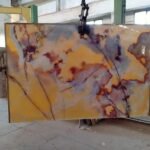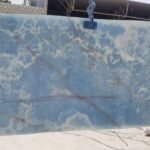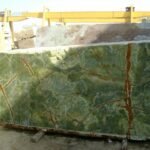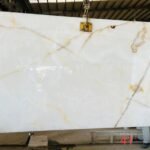The widespread admiration for onyx stems from several factors, including its unique appearance, geological characteristics, cultural significance, and diverse applications. Here are some reasons why onyx captures the admiration of many:
Exquisite Appearance: Onyx boasts stunning natural patterns and colors, ranging from translucent to opaque, with beautiful bands or swirls of various hues, including white, beige, brown, green, red, and black. Its distinct veining and color variations make each piece of onyx unique and visually captivating.
Luxurious Aesthetic: Onyx is associated with luxury and sophistication due to its elegant appearance and historical use in ornate architectural designs, sculptures, and jewelry. Its translucent varieties, in particular, can be backlit to create a mesmerizing glow, adding a touch of opulence to any space.
Versatility: Onyx is a versatile stone that can be polished, honed, or left in its natural state, offering flexibility in design applications. It is commonly used in countertops, backsplashes, flooring, wall cladding, sinks, fireplace surrounds, and decorative accents, enhancing the aesthetic appeal of both residential and commercial spaces.
Cultural and Historical Significance: Onyx has a rich history and holds cultural significance in various civilizations. It has been revered as a symbol of protection, strength, and harmony in different cultures and has been used in rituals, ceremonies, and decorative arts for centuries.
Healing Properties: In metaphysical beliefs, onyx is believed to possess healing properties and spiritual significance. It is associated with grounding energy, protection, and emotional balance, making it a popular choice for jewelry and decorative items with holistic or spiritual purposes.
Durability and Longevity: Onyx is a durable and long-lasting natural stone that can withstand daily wear and tear in high-traffic areas. With proper care and maintenance, onyx surfaces can retain their beauty and luster for generations, making them a timeless investment in interior design.
Eco-Friendly Material: Onyx is a natural material sourced from quarries around the world, making it an eco-friendly choice compared to synthetic or non-renewable materials. Many consumers appreciate its sustainability and organic origin when selecting materials for their homes or businesses.
Overall, the allure of onyx lies in its combination of aesthetic appeal, cultural significance, versatility, and durability, making it a beloved choice for architects, designers, homeowners, and enthusiasts alike.
architect:
project type:
Terms:
client:
Strategy:
date:
Onyx slabs colors and Applications
Onyx slabs come in a variety of colors and are used for various applications in interior design and architecture. Here are some common colors of onyx slabs along with their uses:
White Onyx: White onyx slabs feature translucent white hues with subtle veining. They are often used for countertops, backsplashes, wall cladding, and decorative accents in bathrooms, kitchens, and living spaces. White onyx can create an elegant and luminous ambiance when backlit.
Green Onyx: Green onyx slabs exhibit shades of green ranging from light to dark, with distinctive veining and patterns. They are popular for countertops, vanity tops, fireplace surrounds, and feature walls, adding a touch of natural beauty and sophistication to interior spaces.
Honey Onyx: Honey onyx slabs showcase warm golden hues with translucent properties and intricate veining. They are commonly used for countertops, bar tops, accent walls, and flooring, infusing warmth and richness into residential and commercial environments.
Brown Onyx: Brown onyx slabs feature earthy brown tones with varying degrees of translucency and veining. They are utilized for countertops, tabletops, flooring, and wall panels, imparting a sense of warmth and luxury to contemporary and traditional interiors.
Red Onyx: Red onyx slabs exhibit vibrant shades of red with unique veining and patterns. They are employed for accent walls, backsplashes, vanity tops, and decorative elements, creating striking focal points and adding drama to interior spaces.
Black Onyx: Black onyx slabs boast deep black hues with subtle translucency and distinctive veining. They are favored for countertops, bar tops, flooring, and wall cladding, lending a sense of sophistication and refinement to modern and minimalist designs.
Multi-Colored Onyx: Multi-colored onyx slabs feature a combination of different hues, including white, beige, green, red, and brown, creating visually dynamic patterns and effects. They are used for countertops, feature walls, shower surrounds, and artistic installations, offering versatility and artistic expression in interior design.
Uses of onyx slabs:
- Countertops and Vanity Tops: Onyx slabs are commonly used to create luxurious countertops and vanity tops in kitchens, bathrooms, and bar areas.
- Wall Cladding and Backsplashes: Onyx slabs can be installed as wall cladding or backsplashes to add texture, depth, and visual interest to interior spaces.
- Flooring: Onyx slabs are utilized for flooring applications in residential and commercial settings, providing a striking and durable surface.
- Decorative Accents: Onyx slabs are used to craft decorative accents such as fireplace surrounds, tabletops, sculptures, and lighting fixtures, enhancing the aesthetic appeal of interiors.
- Artistic Installations: Onyx slabs can be creatively used in artistic installations, feature walls, and architectural elements to evoke a sense of drama, elegance, and sophistication.
Overall, onyx slabs offer versatility, beauty, and functionality, making them a popular choice for interior designers, architects, and homeowners seeking to create stunning and memorable spaces.
















